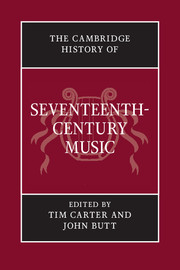Book contents
- Frontmatter
- 1 Renaissance, Mannerism, Baroque
- 2 The seventeenth-century musical ‘work’
- 3 Music in the market-place
- 4 Music in new worlds
- 5 Music and the arts
- 6 Music and the sciences
- 7 The search for musical meaning
- 8 Power and display: music in court theatre
- 9 Mask and illusion: Italian opera after 1637
- 10 The Church Triumphant: music in the liturgy
- 11 Devotion, piety and commemoration: sacred songs and oratorios
- 12 Image and eloquence: secular song
- 13 Fantasy and craft: the solo instrumentalist
- 14 Form and gesture: canzona, sonata and concerto
- Appendix I Chronology
- Appendix II Places and institutions
- Appendix III Personalia
- Index
- References
6 - Music and the sciences
Published online by Cambridge University Press: 28 March 2008
- Frontmatter
- 1 Renaissance, Mannerism, Baroque
- 2 The seventeenth-century musical ‘work’
- 3 Music in the market-place
- 4 Music in new worlds
- 5 Music and the arts
- 6 Music and the sciences
- 7 The search for musical meaning
- 8 Power and display: music in court theatre
- 9 Mask and illusion: Italian opera after 1637
- 10 The Church Triumphant: music in the liturgy
- 11 Devotion, piety and commemoration: sacred songs and oratorios
- 12 Image and eloquence: secular song
- 13 Fantasy and craft: the solo instrumentalist
- 14 Form and gesture: canzona, sonata and concerto
- Appendix I Chronology
- Appendix II Places and institutions
- Appendix III Personalia
- Index
- References
Summary
The relationship between music and the sciences during the seventeenth century is normally characterised as a movement away from music being classified as a mathematical discipline – typically, part of the quadrivium with arithmetic, geometry and astronomy – towards its association with the verbal disciplines, the trivium of grammar, rhetoric and logic, and, above all, the art of poetry. It is certainly true that a new literature on musical poetics emerged around 1600, in which the effects of music were grounded in rhetorical rather than mathematical principles. From this point onwards, composers increasingly aimed to move the passions of their audiences, their express goal now being to portray or represent the gamut of human emotions through the effective union of words and music. That Diderot unhesitatingly located music among the fine arts in his Encylopédie (1751) shows just how much Western sensibilities had altered in the two centuries since Zarlino himself identified music as a mathematical science in his Istitutioni harmoniche (1558).
From the perspective of music history, this generalised account of music’s transformation from a scientific discipline to a poetic art serves well enough. Put simply, the tradition of musica speculativa cultivated by learned fourteenth and fifteenth-century theorists was irrelevant to musicians trying to please audiences within what was becoming an increasingly secular and commercial marketplace. However, even though this concentration on the professionalisation of music as a practical art is understandable, it tells us nothing about the fate of the scientific tradition that was supposedly rejected. With a view to broadening what might be said about ‘music and the sciences’, this chapter starts from the premise that, far from becoming separated, these apparently distinct domains could be as close in the seventeenth century as they had ever been.
- Type
- Chapter
- Information
- The Cambridge History of Seventeenth-Century Music , pp. 132 - 157Publisher: Cambridge University PressPrint publication year: 2005
References
- 3
- Cited by

